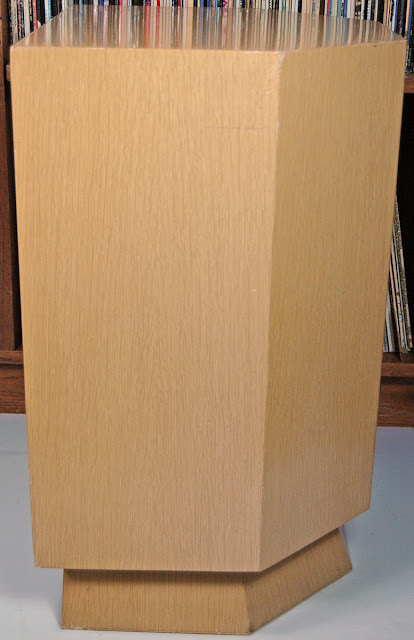Gentle reader,
Some time ago, I found an ancient University brand corner-horn loudspeaker at BThrifty. The first time I looked at it, I passed it by. They only wanted $9.99 for it, but I could see light where the speaker's surround was supposed to be, indicating it was falling apart. Below is what it looked like, but I've already removed the speaker. You can just detect the second piece of wood behind the original panel.
They are called "corner horn" speakers because they are designed to be placed in a room's corner to further enhance the bass. Klipsch is best known for their corner-horn speakers, dating to the 1950's. Below, you can see that the rear of the cabinet is designed to fit in a corner. Also note the cut-out at the bottom rear for the rear waves to exit the cabinet:
Still, a few weeks later it was still there and being 30% off Thursday, I took a chance. Turns out, originally it had a 12" full-range or perhaps coaxial driver in it. Someone in the past had replaced that 12" driver by roughly cutting a piece of plywood and mounting a 10" Wharfedale woofer in it's place over the 12" hole from the rear. Here is the removable front panel after I've installed the tweeter and moved the woofer to a lower location:
Well, as I said, the surround, oddly flat, not convex or concave was mostly gone. No one at Wharfedale USA was any help, far too old. So, the closest replacement foam surround I could find was $15.00 and was too large after all. I had to cut it, and overlap the ends to make it fit the odd-sized UK cone.
To truly make it a full-range speaker, I needed a tweeter. My friend, Cy Bean on Washington state, had a 16 ohm metal tweeter for a good price. I adapted the crossover parts for a Genesis speaker to the two drivers. It had a nominal reading of 13 ohms or so. Too much resistance for all but vintage tube equipment. Thus, my putting my creation on eBay. No takers. (See photo above for what I just typed.)
I'd also found a car speaker at Salvation Army. It had a 10" Alpine metal cone woofer in a cheap carpet-covered cabinet. $15.00. Put it on eBay also, no takers. Upon taking it apart, I found why it sounded so crappy: Too small a cabinet, sealed cabinet, no crossover nor filler. So, the poor thing was trying to compress the air in this tiny box and play notes higher than it was designed for!
So, I tried it in the University cabinet. WOW, now that was some bass! The Alpine could breathe at last! So, next step was a replacement baffle board. That's the wooden panel that the speakers are attached to at the front of a speaker cabinet. Here is is below prior to the new wood:
I bought a 2' by 2' piece of birch 3/4" plywood that was perfect for the job. Carefully centered the driver's hole and added a nice Dayton 4-ohm dual-voice-coil crossover, plus proper filling for the cabinet. Here is the crossover. The coils separate the high frequencies so the woofer does it's work of reproducing the low music only. The black capacitors (four of them) block the low frequencies from reaching the tweeters. This crossover is designed to have outputs for smaller front speakers. This allows the dual-voice-coil subwoofer to handle only the bass which small speakers cannot reproduce. 'Cause they're too small.
Then to keep the sound waves coming from the rear of the driver from simply being absorbed into the carpet the cabinet would be sitting on, I added a bottom piece of 1/4" Lexan sheet. Lexan is nearly unbreakable polycarbonite plastic. I added some closed-cell 1/8" foam tape to the top of the Lexan to further damp the sound wave. Here is the filling below. I placed loose weave fabric in front of the filler to keep it out of the rear of the driver:
Note the port in the photo below which is designed to bring the sound waves from the rearward movement of the driver out to the front and hopefully to reinforce the sound by having the waves meet.
And finally, below is two photos of the finished product. Not shown, (because I forgot to take a photo of it) is the nice dual input panel I installed. This allows both right and left channel's bass is reproduced by the unit.
I tested it with a Telarc CD of Beethoven's Wellington's March with
cannons and muskets. Well, Nancy and Gretchen (our fierce miniature
Dachshund) were downstairs and based on her barking every time a cannon
fired, I'd say it worked. The air being moved front AND rear (via the
reflex port at the bottom of the cabinet) was quite impressive.
Now, to convince someone on eBay to buy it because I have no room, nor need for it!
Thanks for looking!
Scott

















That's not a corner horn. It is a simple vented design with the port on the bottom. It is designed to fit into a corner but corner placement is not essential for its performance. Real corner horns are much more complicated in their internal construction and must be placed in a corner for proper performance. Horn speakers also do not have ports / vents.
ReplyDeleteThanks for reading my blog! Frankly, since I did not know any of the specs of that ancient driver, I was just experimenting.
ReplyDelete